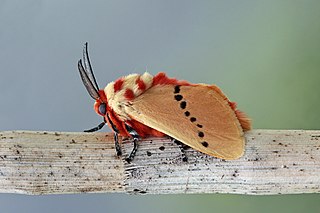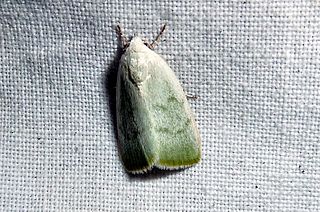
Earias is a genus of moths in the monotypic subfamily Eariadinae of the family Nolidae. The genus was erected by Jacob Hübner in 1825. Species are found throughout Europe, Africa, Asia and Australia, some being agricultural pests such as bollworms.
Cyme is a genus of moths in the family Erebidae. The genus was described by Felder in 1861.

Erebus is a genus of moths in the family Erebidae.

Ugia is a genus of moths in the family Erebidae erected by Francis Walker in 1858.

Spirama is a genus of moths in the family Erebidae first described by Achille Guenée in 1852.

Dichromodes is a genus of moths in the family Geometridae first described by Achille Guenée in 1857. The type species is Dichromodes ainaria.

Earias insulana, the Egyptian stemborer, Egyptian bollworm, spiny bollworm or cotton spotted bollworm, is a moth of the family Nolidae. The species was first described by Jean Baptiste Boisduval in 1833. It is found in most of Africa, southern Europe, the Near East and Middle East, Japan, Taiwan, the Philippines, Australia and Hawaii. It is a rare in immigrant in Great Britain.

Eurema daira, the fairy yellow, barred yellow or barred sulphur, is a butterfly of the family Pieridae. The species was first described by Jean-Baptiste Godart in 1819. It is found from Argentina north to the southern United States. Strays can be found up to southern Arizona, South Dakota, southern Texas and even Washington, D.C.

Trosia is a genus of moths in the family Megalopygidae described by Jacob Hübner in 1820.

Earias vernana is a species of moth in the family Nolidae first described by Johan Christian Fabricius in 1787. It is found in most of southern and central Europe.

Dysaethria is a genus of moths in the family Uraniidae. It was described by Turner in 1911. The species of this genus occur mainly in Asia and in Australia.
Cyme effasciata is a species of moth in the family Erebidae. It is found on Ambon Island in Indonesia. It was described by Felder in 1861.










